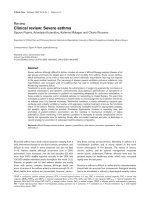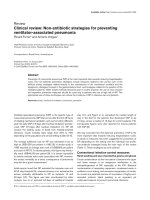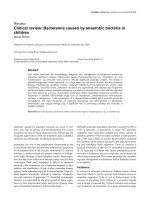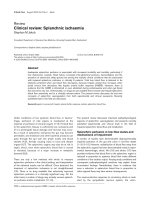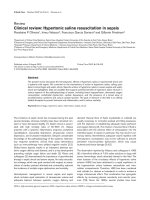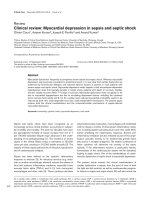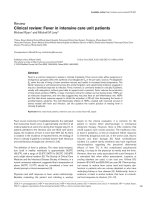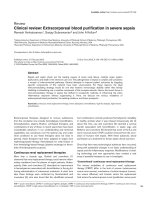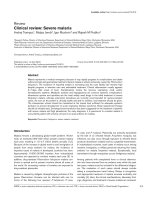Báo cáo y học: "Clinical review: Emergency department overcrowding and the potential impact on the critically il" pot
Bạn đang xem bản rút gọn của tài liệu. Xem và tải ngay bản đầy đủ của tài liệu tại đây (52.63 KB, 5 trang )
291
AMI = acute myocardial infarction; ED = emergency department; EIT = early intervention team; ICU = intensive care unit.
Available online />Abstract
Critical care constitutes a significant and growing proportion of the
practice of emergency medicine. Emergency department (ED)
overcrowding in the USA represents an emerging threat to patient
safety and could have a significant impact on the critically ill. This
review describes the causes and effects of ED overcrowding;
explores the potential impact that ED overcrowding has on care of
the critically ill ED patient; and identifies possible solutions,
focusing on ED based critical care.
Introduction
Critical care begins immediately upon recognition of the
critically ill (or potentially critically ill) patient, who has been
defined as ‘any patient who is physiologically unstable,
requiring constant and minute-to-minute titration of therapy
according to the evolution of the disease process’ [1].
Therefore, the spectrum of critical care is not limited to the
care that is provided within the confines of the intensive care
unit (ICU). Rather, critical care begins (and is often
necessitated) outside the ICU setting [2]. The nature of the
illness rather than the location of the patient defines the need
for critical care [1]; therefore, critical care patients are best
defined physiologically rather than geographically. Outside the
ICU and postoperative recovery rooms, critical care is most
commonly provided in the emergency department (ED) [3].
Critical care constitutes a significant and growing proportion
of ED practice [4–6]. Studies conducted in urban US EDs
have reported that more than 150 days of critical care time
are provided in an ED annually [5,6]. Many EDs have
optimized their ability to deliver certain aspects of critical care
for very specific scenarios, such as trauma, acute
cerebrovascular accidents, and acute myocardial infarctions
(AMIs). Although EDs are designed to provide emergent
stabilization and initial therapy for critically ill patients, most
EDs do not have ICU-level resources for optimal longitudinal
critical care delivery (such as uninterrupted 1 : 1 nursing care,
focused subspecialty expertise, and invasive hemodynamic
monitoring). Currently, the provision of critical care in the ED
is increasing (in terms of both frequency and duration), largely
because of ED overcrowding [5,7].
This review describes the causes and effects of ED
overcrowding in the USA; explores the potential impact this
has on the care of the critically ill ED patient; and identifies
possible solutions, focusing on innovations in ED based
critical care.
Emergency department overcrowding
In order to meet the increasing need for emergency services,
many US EDs are being pushed to their maximum capacity.
Although no strict definition exists, ‘ED overcrowding’ refers
to an extreme volume of patients in ED treatment areas,
forcing the ED to operate beyond its capacity [8]. This
overcrowding is potentially associated with exceeding
conventional nurse : patient ratios, providing medical care in
makeshift patient care areas (e.g. triage areas and hallways),
and diverting ambulances to other institutions [9].
Overcrowding usually leads to extremely long wait times,
especially for those patients who are not critically ill, which
leads to patient dissatisfaction, patient walkouts, and the
potential for compromised medical care.
Although the exact incidence of ED overcrowding has not
been studied in rigorous prospective investigations, wide-
spread ED overcrowding has been cited by survey studies in
Review
Clinical review: Emergency department overcrowding and the
potential impact on the critically ill
Robert M Cowan
1
and Stephen Trzeciak
2
1
Chief Resident, Department of Emergency Medicine, UMDNJ-Robert Wood Johnson Medical School at Camden, Cooper University Hospital,
Camden, New Jersey, USA
2
Assistant Professor, Department of Emergency Medicine and the Section of Critical Care Medicine, UMDNJ-Robert Wood Johnson Medical School at
Camden, Cooper University Hospital, Camden, New Jersey, USA
Corresponding author: Robert M Cowan,
Published online: 14 October 2004 Critical Care 2005, 9:291-295 (DOI 10.1186/cc2981)
This article is online at />© 2004 BioMed Central Ltd
292
Critical Care June 2005 Vol 9 No 3 Cowan and Trzeciak
the literature [10–14]. According to a 2001 report, 91% of
US ED directors (525 out of 575 directors) reported
problematic crowding in their departments, and 39%
reported overcrowding on a daily basis [11]. A recent survey
conducted by the American Hospital Association reported
that the percentage of large hospital EDs that are
consistently operating ‘at or above capacity’ has reached
90% [14]. In the lay press, numerous reports have
documented breaches of patient safety because of
overcrowding, and these reports have questioned the ability
of the entire US emergency care system to provide safe care
during the current surge in demand for emergency services.
Causes
The causes of ED overcrowding are complex and multifactorial
[15–17]. The primary determinants of ED overcrowding are
not related to patient throughput inside the ED but actually
originate outside the ED [18]. Of these, the two most
important determinants of ED overcrowding pertaining to the
critically ill are an increasing volume of high-acuity patients
presenting to the ED and insufficient inpatient capacity.
Between 1992 and 1999, ED visits rose 14% from 89.8
million to 102.8 million visits annually, with the steepest gains
in volume over the last 2 years of that time period [19]. While
this increase in patient volume took place in the 1990s, 1128
EDs closed their doors [20]. As a result, more visits are being
concentrated in fewer EDs. An increasing proportion of these
patients are high-acuity patients who require critical care.
Lambe and coworkers [7] reported a 59% increase in critically
ill patients presenting to California EDs from 1990 to 1999.
The increasing severity of illness among ED patients has been
attributed to age shifts in the population and a higher
prevalence of patients with severe chronic medical conditions.
Considering the projected future growth in critically ill
populations as a whole [21], this trend toward increasing
severity of illness among ED patients will probably continue.
Although escalating patient acuity places a large strain on ED
resources, the most important cause of ED overcrowding is
insufficient inpatient capacity for ED patients who require
hospital admission [8,22,23]. A lack of inpatient beds is also
the most important contributor to ambulance diversion [24].
The number of inpatient hospital beds in the USA has declined
sharply over the past 2 decades. Between 1981 and 1999 the
total number of inpatient beds decreased by 39% [23]. This
cutback has largely been the result of managed care initiatives
and hospital cost-containment strategies. Eliminating inpatient
beds maximizes the hospital census and ensures a ‘full house’
at all times, which is favorable from a financial standpoint [9].
However, when hospitals are perpetually functioning at greater
than 90% of their inpatient capacity, they are ill equipped to
handle surges in the number of admissions [25]. The current
US nursing shortage exacerbates the lack of inpatient capacity
by further decreasing the number of staffed beds available to
offload an overcrowded ED.
Effects
Inadequate inpatient capacity for a patient population with
increasing severity of illness forces the ED to serve as a
holding area for admitted patients. The term ‘boarding’ refers to
patients who are admitted to the hospital but who remain in the
ED, sometimes for more than 24 hours, because of the lack of
available beds [8,18,26]. Critically ill patients are no exception
because ICU patients may also board in the ED for
extraordinarily long periods until an ICU bed becomes available
[4]. A recent report from the American Hospital Association
[14] indicated that the average waiting time for an inpatient
acute or critical care bed in US EDs is more than 3 hours, but
the average waiting time nearly doubles (5.8 hours) in hospitals
that consistently have ED overcrowding [14].
EDs are designed for rapid triage, stabilization, and initial
treatment. When boarding in the ED causes a ‘gridlock’, the
ED becomes the site for ongoing (i.e. longitudinal) care in the
acute phase of hospitalization. In this scenario EDs must
provide ongoing care for critically ill patients, effectively
serving as expandable extensions of the ICU or ‘de facto
ICUs’ [27]. However, EDs are not designed, equipped, or
staffed to provide continuing care for the critically ill patient.
Although most EDs have specialized areas in which they care
for patients who present with trauma and AMI, most do not
have the ability to perform invasive hemodynamic monitoring,
including arterial and pulmonary artery catheterization. They
are designed for rapid stabilization, including resuscitation
from cardiac arrest (i.e. ‘code’ situations), but not for
extended care.
Conventional ED nurse : patient ratios do not typically allow
for the focused attention that a patient could receive in a
critical care unit because most ED nurses are simultaneously
responsible for numerous patients with varying severities of
illness. When a nurse is assigned to an ICU patient boarding
in the ED, one of two scenarios can be expected to occur;
either the ideal 1 : 1 or 1 : 2 critical care nurse : patient ratio
will be compromised, or the rest of the ED nursing staff will
be required to absorb a greater proportion of ED patients.
Boarding in the ED is not only reported to be a barrier to
specialized inpatient care, but it also has been identified as a
potential high-risk environment for medical errors [8].
Critically ill patients boarding in the ED are physically
separated from the watchful eye of the intensivists who are
ultimately responsible for their care. All of these factors could
potentially lead to delays in recognizing deterioration in a
patient’s condition and in initiating critical interventions, and
may detract from optimal patient care.
ED overcrowding has been reported to compromise patient
safety, and the critically ill are an especially vulnerable
population and are at-risk for serious adverse events.
Although the impact of ED overcrowding on patient outcome
has not yet been investigated in rigorous prospective
293
observational studies, survey studies in the literature have
linked ED overcrowding to clinically significant delays in
diagnosis and treatment, as well as to poor patient outcomes
[10,15]. One report [10] linked ED overcrowding to delays in
identification and treatment of time-sensitive conditions, such
as acute coronary syndrome, stroke, surgical emergencies,
and septic shock. ED overcrowding has also been shown to
cause ambulance diversion and significant delays in
ambulance transport for patients with acute cardiac
emergencies [28,29], regardless of the severity of illness
[28]. A recent study reported that ED overcrowding was
associated with delays in door-to-needle time for AMI [30].
According to the Joint Commission on Accreditation of
Healthcare Organizations [31], one half of all ‘sentinel event’
cases of poor outcomes that were attributable to delays in
therapy originated in the ED, with ED overcrowding playing a
role in almost one-third of these cases.
In addition to delays in therapy, ED overcrowding may also
have an impact on the speed at which critical illness is
recognized, through ambulance diversion, triage delays, and
delays in bringing patients into treatment rooms. ED
overcrowding may also result in extraordinarily long waiting
times, causing some patients to leave the ED without being
seen by a physician. Patients in the early hours of disease
presentation who are initially well appearing and triaged as
‘nonemergent’ have the potential to leave the hospital without
treatment and could become severely ill outside the hospital.
Boarding in the ED can subject critically ill patients to
recognition and treatment delays at a pivotal point in the
hospital course when time-sensitive interventions are
necessary. Because optimal delivery of critical care in the
early hours of disease presentation is often time-sensitive (i.e.
cardiogenic shock [32], hemodynamic optimization in severe
sepsis [33,34], and the ‘golden hour’ of trauma [35,36]),
impediments to prompt critical care recognition and delivery
in the ED setting could potentially represent a threat to
patient safety.
Adding to the current landscape of ED critical care capacity
is the potential threat of terrorism and other disasters. The
readiness of US EDs to care for critically ill victims is a key
element in preparedness for terrorism or bioterrorism. In a
terrorist attack with either conventional or biologic weapons,
a large volume of patients would be expected to require
critical care services, including mechanical ventilation and
hemodynamic support [37]. Overcrowded EDs could be
poorly prepared to handle mass casualty victims [16].
Potential solutions: innovations in emergency
department based critical care
There is no simple solution to ED overcrowding. Opinion
leaders have reported that ED overcrowding will not be
alleviated until hospitals adopt a multidisciplinary, system
wide approach focused on solutions to inpatient capacity
constraints [18,27]. Strategic planning by hospital
administration has been advocated by the Joint Commission
on Accreditation of Healthcare Organizations [38], including
expedition of patient transfers out of critical care areas,
anticipation of delivery of care to patients who must be
placed in temporary bed locations, and incorporation of ED
overcrowding initiatives into hospital performance improve-
ment goals. In addition, it has also been suggested that
hospitals coordinate operating room scheduling (for patients
who are likely to need ICU care postoperatively) with the
anticipated cyclic patterns of increased ED patient visits, in
which particular days have predictably higher ED volumes.
Operating room scheduling is an important component of
strategic planning for critical care needs and avoiding
gridlock in the hospital [39].
Despite these steps, ED boarding in the USA is unlikely to be
significantly alleviated in the near future. Thus, for any critically
ill patient boarding in the ED, the ability to recognize and deliver
prompt ED based critical care may be crucial in ensuring
patient safety. In the era of ED boarding, innovative solutions
are needed to provide alternatives to the ongoing acute phase
management of the critically ill. If critically ill ED patients cannot
be taken rapidly to the critical care unit, then it is necessary to
find new ways to take critical care to the patient [3]. This is the
concept of ‘critical care without walls’ [2].
ED based critical care is not intended to be a substitute for
conventional critical care provided within the ICU, and neither
is it intended to delay or hold a patient in the ED any longer
than is absolutely necessary. Critical care provided in the ED
would simply be a temporizing measure until an ICU bed
becomes available. ED based critical care requires an
institutional commitment to ED infrastructure. The necessary
infrastructure would include the following components: a
dedicated resuscitation area in the ED; ability to perform
basic hemodynamic monitoring (i.e. including but not limited
to measurements of central venous pressure, arterial blood
pressure, and mixed venous/central venous oximetry);
mechanical ventilation capability, including dedicated
respiratory therapy staff; and a training program for ED
nursing staff so that they may develop proficiency in
hemodynamic monitoring and mechanical ventilation. All of
these capabilities could be present in the Society for
Academic Emergency Medicine’s vision for a ‘level one’
emergency center [40].
For an emergency physician, the perpetual task of maximizing
patient throughput for the entire ED is not compatible with
the ongoing provision of comprehensive critical care for an
individual patient. Therefore, the physician coverage for
critical care patients boarding in the ED must be clearly
defined. There are three different models for expanding
physician coverage in order to provide ongoing focused
critical care in the ED setting: the ICU-centric model, the ED-
centric model, and the collaborative ED–ICU model.
Available online />294
The ICU-centric model
In the ICU-centric model, the critical care consultant would
take over responsibility for any critically ill patient in the
hospital at the time of patient identification, regardless of
location. This would include critically ill patients boarding in
the ED. Transfer of care would occur at the time of
consultation, assuming that the patient meets criteria for
admission to the critical care service. This would best be
accomplished with an ‘intensivist model’ of staffing ICUs
[41], in which a physician trained in multidisciplinary critical
care is available around the clock [42]. For patients boarding
in the ED, the emergency physician would still be in close
proximity to respond to sudden major physiologic
decompensations but they would not be responsible for
ongoing critical care. This would allow the emergency
physician to focus on patient throughput for the rest of the
ED patients, and may also decrease ‘hand-off’ errors during
patient transition because the intensivists would assume
control earlier in the patient’s course.
The ED-centric model
In the ED-centric model, responsibilities for patient care
would be site defined. The ED physicians would take full
responsibility for all critical care provided in the ED,
regardless of how long a patient may be boarding there.
Responsibility for patient care would not be transitioned to
critical care staff until the patient arrives in the ICU.
One example of this model is the early intervention team (EIT)
at Henry Ford Hospital (Detroit, MI, USA). Their ED-based EIT
program was created to provide focused care for critically ill
patients (specifically severe sepsis patients) in the ED
setting. The EIT was founded on the principles that optimal
delivery of critical care can be time sensitive, and that
aggressive ED based critical care interventions can rapidly
improve critical physiology and have a positive impact on
outcome. The Department of Emergency Medicine provides
all of the EIT infrastructure (including additional personnel,
physician training, nursing training, physical plant
modifications, and critical care equipment) and maintains the
program exclusive from all inpatient critical care services.
Essentially, they have built an acute-phase critical care unit in
the ED. The EIT physicians send the patient to the inpatient
ICU after prospectively defined end-points of resuscitation
have been met. ED physicians (including resident physician
trainees) staff the program and provide ongoing focused
critical care at the bedside, allowing the other emergency
physicians to focus on throughput for the noncritical ED
patients (Rivers EP, personal communication, 2004).
The collaborative model
During the transition of patient care from ED to ICU staff, the
use of collaborative evidence-based ED–ICU treatment
protocols can help to facilitate uniformity of patient care. The
use of protocols to complement clinical decision making for
the critically ill has been shown to decrease unnecessary
variations in clinical practice [43]. Protocol-directed care has
already gained acceptance in the management of glycemic
control [44], sedation [45], and weaning from mechanical
ventilation [46–48], but acute phase resuscitation can be
guided by protocol as well [33,34]. Although applicable in all
three models, collaborative protocols are more beneficial in
this model because there will probably be variability in clinical
decision making when patients are co-managed by two
different teams of physicians. Collaborative protocols may
help to reduce transitional errors and to streamline care.
At our institution (Cooper University Hospital, Camden, NJ,
USA), a collaborative ED–ICU sepsis resuscitation protocol
(an adaptation of the protocol described by Rivers and
coworkers [34]) was recently adopted as an institutional
‘best practice’ model. The ED staff is responsible for patient
identification and rapid protocol initiation. Per protocol, the
critical care physician is automatically consulted at the time
of patient identification for ongoing management. The
protocol guides early resuscitative efforts in the ED and
carries over to the initial phase of the ICU course as patient
care is transitioned to the ICU team. Although transfer of
patient care responsibilities (from ED to ICU services)
officially occurs at the time of critical care consultation, the
ED physicians continue to supervise protocol execution
while the patient is boarding in the ED. Before instituting the
resuscitation protocol, we held in-service training for our ED
nursing staff and we trained all of our junior resident
physicians in fundamental critical care support [49]. In the
future, protocol directed resuscitation might be applicable to
shock profiles other than sepsis. Conceptually, a
collaborative ED–ICU model can facilitate a seamless
transition on the continuum of critical care, as envisioned by
the late Dr Peter Safar [50].
Conclusion
Critical care constitutes a significant and growing proportion
of the practice of emergency medicine. ED overcrowding
(i.e. ‘boarding’ in the ED) can have an adverse impact on
patient safety, especially for the critically ill ED patient.
Innovative solutions are needed to provide optimal care for
the ongoing acute phase management of the critically ill in
the ED setting.
Competing interests
The author(s) declare that they have no competing interests.
References
1. Brilli RJ, Spevetz A, Branson RD, Campbell GM, Cohen H, Dasta
JF, Harvey MA, Kelley MA, Kelly KM, Rudis MI, et al.: Critical care
delivery in the intensive care unit: defining clinical roles and
the best practice model. Crit Care Med 2001, 29:2007-2019.
2. Hillman K: Critical care without walls. Curr Opin Crit Care 2002,
8:594-599.
3. Rivers EP, Nguyen HB, Huang DT, Donnino MW: Critical care
and emergency medicine. Curr Opin Crit Care 2002, 8:600-606.
4. Varon J, Fromm RE Jr, Levine RL: Emergency department pro-
cedures and length of stay for critically ill medical patients.
Ann Emerg Med 1994, 23:546-549.
Critical Care June 2005 Vol 9 No 3 Cowan and Trzeciak
295
5. Fromm RE Jr, Gibbs LR, McCallum WG, Niziol C, Babcock JC,
Gueler AC, Levine RL: Critical care in the emergency depart-
ment: a time-based study. Crit Care Med 1993, 21:970-976.
6. Nelson M, Waldrop RD, Jones J, Randall Z: Critical care pro-
vided in an urban emergency department. Am J Emerg Med
1998, 16:56-59.
7. Lambe S, Washington DL, Fink A, Herbst K, Liu H, Fosse JS,
Asch SM: Trends in the use and capacity of California’s emer-
gency departments, 1990–1999. Ann Emerg Med 2002, 39:
389-396.
8. Gordon JA, Billings J, Asplin BR, Rhodes KV: Safety net
research in emergency medicine: proceedings of the Acade-
mic Emergency Medicine Consensus Conference on ‘The
Unraveling Safety Net’. Acad Emerg Med 2001, 8:1024-1029.
9. Schull MJ, Szalai JP, Schwartz B, Redelmeier DA: Emergency
department overcrowding following systematic hospital
restructuring: trends at twenty hospitals over ten years. Acad
Emerg Med 2001, 8:1037-1043.
10. Derlet RW, Richards JR: Emergency department overcrowding
in Florida, New York, and Texas. South Med J 2002, 95:846-
849.
11. Derlet R, Richards J, Kravitz R: Frequent overcrowding in U.S.
emergency departments. Acad Emerg Med 2001, 8:151-155.
12. Andrulis DP, Kellermann A, Hintz EA, Hackman BB, Weslowski
VB: Emergency departments and crowding in United States
teaching hospitals. Ann Emerg Med 1991, 20:980-986.
13. Richards JR, Navarro ML, Derlet RW: Survey of directors of
emergency departments in California on overcrowding. West J
Med 2000, 172:385-388.
14. The Lewin Group: Emergency Department Overload: A Growing
Crisis. The Results of the American Hospital Association Survey
of Emergency Department (ED) and hospital capacity. Vol. 2002,
2002. [ />content/EdoCrisisSlides.pdf]
15. Derlet RW, Richards JR: Overcrowding in the nation’s emer-
gency departments: complex causes and disturbing effects.
Ann Emerg Med 2000, 35:63-68.
16. Trzeciak S, Rivers EP: Emergency department overcrowding in
the United States: an emerging threat to patient safety and
public health. Emerg Med J 2003, 20:402-405.
17. Richardson LD, Hwang U: Access to care: a review of the
emergency medicine literature. Acad Emerg Med 2001, 8:
1030-1036.
18. Schneider S, Zwemer F, Doniger A, Dick R, Czapranski T, Davis
E: Rochester, New York: a decade of emergency department
overcrowding. Acad Emerg Med 2001, 8:1044-1050.
19. Burt CW, McCaig LF: Trends in hospital emergency depart-
ment utilization: United States, 1992-99. Vital Health Stat
2001, 13:1-34.
20. American College of Emergency Physicians: Emergency medi-
cine statistical profile 2001. []
21. Angus DC, Kelley MA, Schmitz RJ, White A, Popovich J Jr: Caring
for the critically ill patient. Current and projected workforce
requirements for care of the critically ill and patients with pul-
monary disease: can we meet the requirements of an aging
population? JAMA 2000, 284:2762-2770.
22. Richardson LD, Asplin BR, Lowe RA: Emergency department
crowding as a health policy issue: past development, future
directions. Ann Emerg Med 2002, 40:388-393.
23. American Hospital Association. Hospital Statistics, 1999. [http://
www.hospitalconnect.com/healthforum/hfstats/downloads.html]
24. Schull MJ, Lazier K, Vermeulen M, Mawhinney S, Morrison LJ:
Emergency department contributors to ambulance diversion:
a quantitative analysis. Ann Emerg Med 2003, 41:467-476.
25. Bagust A, Place M, Posnett JW: Dynamics of bed use in
accommodating emergency admissions: stochastic simula-
tion model. BMJ 1999, 319:155-158.
26. Henry M: Overcrowding in America’s emergency departments:
inpatient wards replace emergency care. Acad Emerg Med
2001, 8:188-189.
27. Derlet RW: Overcrowding in emergency departments:
increased demand and decreased capacity. Ann Emerg Med
2002, 39:430-432.
28. Schull MJ, Morrison LJ, Vermeulen M, Redelmeier DA: Emer-
gency department gridlock and out-of-hospital delays for
cardiac patients. Acad Emerg Med 2003, 10:709-716.
29. Schull MJ, Morrison LJ, Vermeulen M, Redelmeier DA: Emer-
gency department overcrowding and ambulance transport
delays for patients with chest pain. CMAJ 2003, 168:277-283.
30. Schull MJ: Overcrowding of Ontario emergency departments
and door-to-needle time delays in acute myocardial infarction
[abstract]. Can J Emerg Med, in press.
31. Joint Commission on Accreditation of Healthcare Organizations
(JCAHO): Sentinel Event Alert 2002, Issue 26. [http://www.
jcaho.org/about+us/news+letters/sentinel+event+alert/print/sea_
26.htm]
32. Hochman JS, Sleeper LA, Webb JG, Sanborn TA, White HD,
Talley JD, Buller CE, Jacobs AK, Slater JN, Col J, et al.: Early
revascularization in acute myocardial infarction complicated
by cardiogenic shock. SHOCK Investigators. Should we emer-
gently revascularize occluded coronaries for cardiogenic
shock? N Engl J Med 1999, 341:625-634.
33. Carcillo JA, Fields AI: Clinical practice parameters for hemody-
namic support of pediatric and neonatal patients in septic
shock. Crit Care Med 2002, 30:1365-1378.
34. Rivers E, Nguyen B, Havstad S, Ressler J, Muzzin A, Knoblich B,
Peterson E, Tomlanovich M; Early Goal-Directed Therapy Collabo-
rative Group: Early goal-directed therapy in the treatment of
severe sepsis and septic shock. N Engl J Med 2001, 345:
1368-1377.
35. Cowley RA: The resuscitation and stabilization of major multi-
ple trauma patients in a trauma center environment. Clin Med
1976, 83:16-22.
36. Blow O, Magliore L, Claridge JA, Butler K, Young JS: The golden
hour and the silver day: detection and correction of occult
hypoperfusion within 24 hours improves outcome from major
trauma. J Trauma 1999, 47:964-969.
37. Karwa M, Bronzert P, Kvetan V: Bioterrorism and critical care.
Crit Care Clin 2003, 19:279-313.
38. Joint Commission on Accreditation of Healthcare Organizations
(JCAHO): Emergency department overcrowding field review.
[ />field+reviews/ed_fr_std.htm]
39. McManus ML, Long MC, Cooper A, Mandell J, Berwick DM,
Pagano M, Litvak E: Variability in surgical caseload and access
to intensive care services. Anesthesiology 2003, 98:1491-
1496.
40. Goldfrank L, Henneman PL, Ling LJ, Prescott JE, Rosen C, Sama
A: Emergency center categorization standards. Acad Emerg
Med 1999, 6:638-655.
41. Pronovost PJ, Angus DC, Dorman T, Robinson KA, Dremsizov TT,
Young TL: Physician staffing patterns and clinical outcomes in
critically ill patients: a systematic review. JAMA 2002, 288:
2151-2162.
42. The Leapfrog Group: Fact Sheet: ICU Staff. The Leapfrog Group
for Patient Safety; 2004. [ />ICU_FactSheet.pdf]
43. Holcomb BW, Wheeler AP, Ely EW: New ways to reduce
unnecessary variation and improve outcomes in the intensive
care unit. Curr Opin Crit Care 2001, 7:304-311.
44. Brown G, Dodek P: Intravenous insulin nomogram improves
blood glucose control in the critically ill. Crit Care Med 2001,
29:1714-1719.
45. Brook AD, Ahrens TS, Schaiff R, Prentice D, Sherman G,
Shannon W, Kollef MH: Effect of a nursing-implemented seda-
tion protocol on the duration of mechanical ventilation. Crit
Care Med 1999, 27:2609-2615.
46. Ely EW, Meade MO, Haponik EF, Kollef MH, Cook DJ, Guyatt GH,
Stoller JK: Mechanical ventilator weaning protocols driven by
nonphysician health-care professionals: evidence-based clini-
cal practice guidelines. Chest 2001, Suppl:454S-463S.
47. Kollef MH, Shapiro SD, Silver P, St John RE, Prentice D, Sauer S,
Ahrens TS, Shannon W, Baker-Clinkscale D: A randomized, con-
trolled trial of protocol-directed versus physician-directed
weaning from mechanical ventilation. Crit Care Med 1997, 25:
567-574.
48. Marelich GP, Murin S, Battistella F, Inciardi J, Vierra T, Roby M:
Protocol weaning of mechanical ventilation in medical and
surgical patients by respiratory care practitioners and nurses:
effect on weaning time and incidence of ventilator-associated
pneumonia. Chest 2000, 118:459-467.
49. Dellinger RP: Fundamental critical care support: another merit
badge or more? Crit Care Med 1996, 24:556-557.
50. Safar P: The critical care continuum from scene to outcome. In
Major Issues in Critical Care Medicine. Edited by Parrillo JE, Ayers
SM. Baltimore, MD: Williams and Wilkins; 1984:71-84.
Available online />
